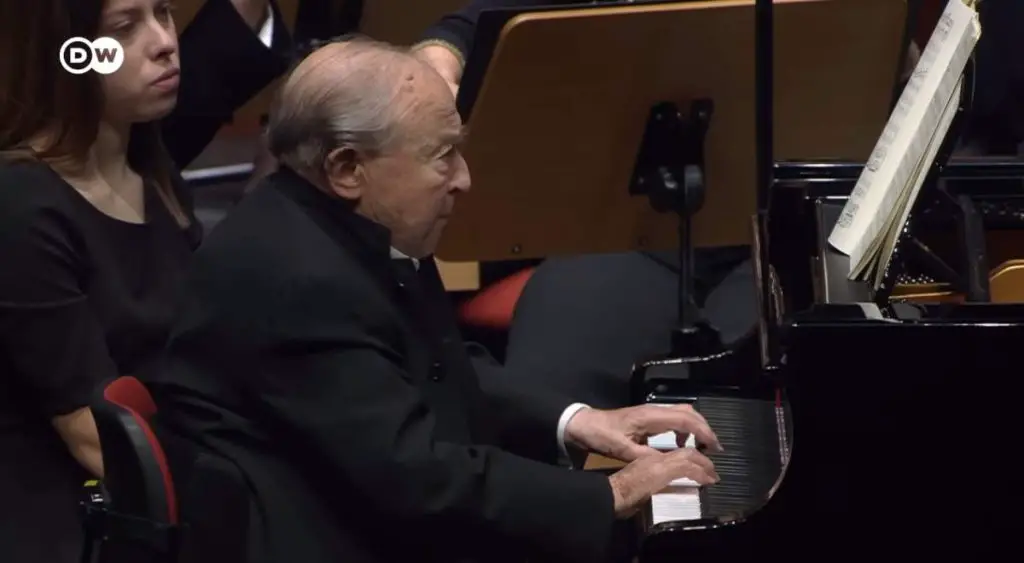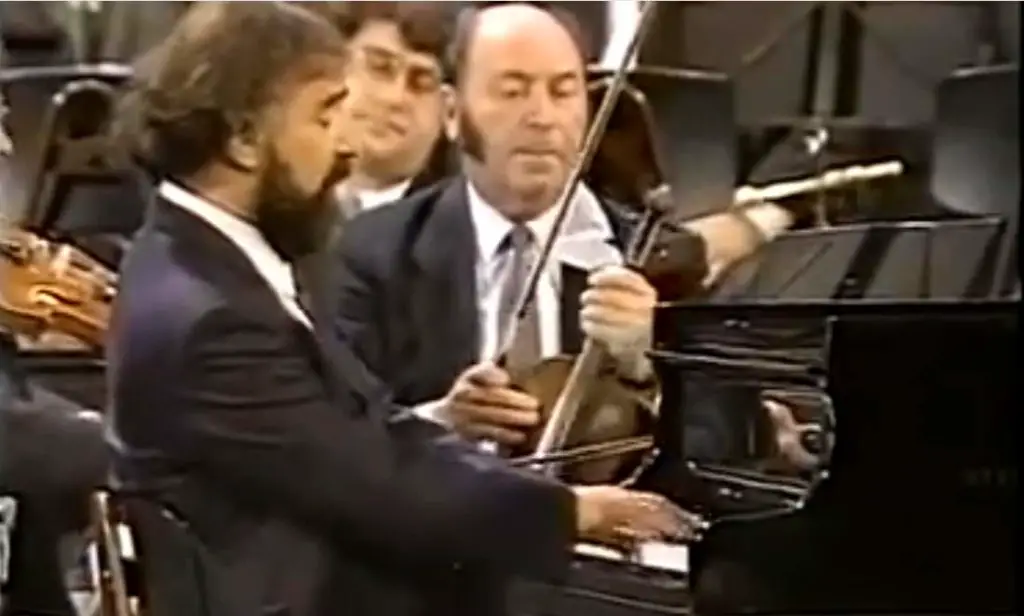Accompanied by the SWR Symphonieorchester Stuttgart, the German-Korean pianist Christopher Park performs Wolfgang Amadeus Mozart’s Piano Concerto No. 23 in A major (K. 488). Conductor: Christoph Eschenbach. This performance was recorded at the Liederhalle Stuttgart, in November 2017.
Mozart’s Piano Concerto No. 23
Wolfgang Amadeus Mozart’s Piano Concerto No. 23 in A major, K. 488, is a work of great charm and elegance, composed in 1786 during a period of high creativity for Mozart. This period was also the time when he wrote some of his other major works, such as “The Marriage of Figaro” and several other piano concertos.
The concerto stands out for its lyrical quality and the delicate interplay between the piano and the orchestra. Mozart, a master of the concerto form, demonstrates his skill in blending the solo piano with the ensemble, creating a conversation rather than a competition between the two. The orchestration is refined and thoughtfully crafted, with Mozart employing clarinets instead of oboes, which was a relatively novel choice at the time. This substitution gives the concerto a warmer, more mellow sound that complements the piano’s timbre beautifully.
The emotional depth of the concerto is noteworthy. While it is fundamentally classical in style, with clear structures and balanced forms, it also contains moments of deep expressiveness and introspection. The concerto’s overall mood is one of brightness and grace, but it is also touched with moments of melancholy and introspection, typical of Mozart’s later works.
Mozart, being a virtuosic pianist himself, wrote the piano part with a deep understanding of the instrument’s capabilities. The piano lines are lyrical, rich, and expressive, offering both technical challenges and opportunities for expressive playing. The concerto is a favorite among pianists and audiences alike, appreciated for its lyrical melodies, masterful orchestration, and the emotional depth that Mozart so effortlessly conveys.
The concerto’s place in Mozart’s oeuvre is significant. It is a reflection of his mature style, characterized by a seamless blend of elegant classicism and emotional expressiveness. This piece, like many of Mozart’s piano concertos, was likely intended for his own performance, allowing him to showcase his considerable talents as a composer and pianist.
Movements
There are three movements. With start times in the video:
- 00:00 Allegro
- 11:33 Adagio
- 18:58 Allegro assai
1. Allegro
The first movement of Mozart’s Piano Concerto No. 23 in A major, K. 488, is a shining example of his mastery in marrying the elegance of the classical concerto form with his unique expressive depth. This movement, marked as Allegro, is characterized by its lively tempo and graceful, flowing melodies.
One of the distinctive features of this movement is the opening theme introduced by the orchestra. This theme sets a joyful and sophisticated tone, typical of Mozart’s style. The piano enters after this orchestral exposition, echoing and elaborating on the themes introduced by the orchestra. Mozart’s use of the piano in this concerto is not just as a solo instrument but as an integral part of the musical conversation with the orchestra.
The development of the movement is a testament to Mozart’s compositional skill. He expertly weaves the piano and orchestra together, exploring different keys and themes. The interplay between the soloist and the ensemble is seamless, with the piano often leading the way into new thematic material or providing a lyrical counterpoint to the orchestra’s statements.
A notable aspect of this movement is the clarity of its structure. It follows the typical sonata form used in classical concertos, consisting of an exposition, development, and recapitulation. However, Mozart infuses this structure with his characteristic inventiveness and emotional depth. The themes are developed in a way that feels both natural and surprising, leading the listener through a rich musical landscape.
The piano writing in this movement is both brilliant and expressive. Mozart requires the soloist to navigate intricate passages, rapid scales, and delicate ornamentations, all while maintaining a sense of lyrical expression. The cadenza, typically improvised by the performer or written by the performer or other composers in Mozart’s time, is a moment where the soloist can showcase their technical and expressive abilities. In modern performances, pianists often choose between existing cadenzas written by Mozart or other composers, or even compose their own.
2. Adagio
The second movement of Mozart’s Piano Concerto No. 23 in A major, K. 488, is a profound and deeply expressive Adagio. This movement is often noted for its stark contrast to the vivacious and elegant first movement, revealing a more introspective and emotive side of Mozart’s musical genius.
The Adagio opens with a quiet and poignant melody in the strings, immediately setting a somber and contemplative mood. This theme is characterized by its simple yet profound beauty, a hallmark of Mozart’s ability to convey deep emotion through seemingly uncomplicated musical lines. The piano enters delicately, intertwining with and expanding upon the orchestral theme. The interplay between the piano and the orchestra in this movement is more subdued and introspective compared to the first movement, yet it remains deeply communicative and expressive.
One of the remarkable aspects of this movement is its harmonic language. Mozart employs a rich palette of harmonies that adds to the emotional depth of the music. The movement is in F-sharp minor, a key not frequently used by Mozart and one that lends a particularly plaintive and melancholic character to the music. The use of this key, along with Mozart’s masterful modulations, creates moments of tension and release that are profoundly moving.
The piano’s role in this movement is more reflective and lyrical than virtuosic. The soloist is called upon to express the nuanced emotions of the piece through subtle phrasing, dynamics, and expressive timing. The piano lines, while not technically demanding in terms of speed or complexity, require a deep sense of musicality and emotional understanding.
The overall mood of the Adagio is one of introspection and melancholy, but it is not without moments of hope and beauty. Mozart’s music here is a delicate balance of sadness and tranquility, with the piano and orchestra weaving together to create a tapestry of sound that is both poignant and serene.
3. Allegro assai
The third movement of Mozart’s Piano Concerto No. 23 in A major, K. 488, is a lively and spirited Allegro assai, marking a return to the cheerful and energetic mood that characterizes much of Mozart’s music. This final movement serves as a delightful and upbeat conclusion to the concerto, contrasting sharply with the introspective and somber mood of the second movement.
In this movement, Mozart showcases his skill in creating a sense of joy and vivacity through rhythmic vitality and playful interaction between the piano and the orchestra. The movement opens with an energetic theme introduced by the orchestra, which sets a buoyant and lively tone. The piano soon enters, echoing and elaborating on this theme with sparkling runs and lively ornamentations.
A key feature of this movement is its rondo form, a common structure for final movements in classical concertos. In a rondo, the main theme (the “refrain”) alternates with contrasting sections (the “episodes”). Mozart ingeniously weaves these sections together, creating a tapestry of varying moods and colors while always returning to the spirited main theme.
The piano writing in this movement is both playful and technically demanding. The soloist is required to perform rapid passages, trills, and quick changes in dynamics, all while maintaining a sense of lightness and clarity. The virtuosity required is not just for show; it adds to the overall sense of joy and exuberance that permeates the movement.
The interplay between the solo piano and the orchestra is also a highlight of this movement. Mozart creates a dialogue between the two, with the piano sometimes leading the way and at other times responding to the orchestra. This back-and-forth is seamless and adds to the lively character of the music.
Mozart’s mastery of orchestration is evident in how he uses the instruments to enhance the mood and character of the music. The woodwinds, in particular, have a prominent role, adding color and contrast to the piano’s lines.
Sources
- Piano Concerto No. 23 (Mozart) on Wikipedia
- Piano Concerto No. 23 in A, K. 488 on the LA Phil website


